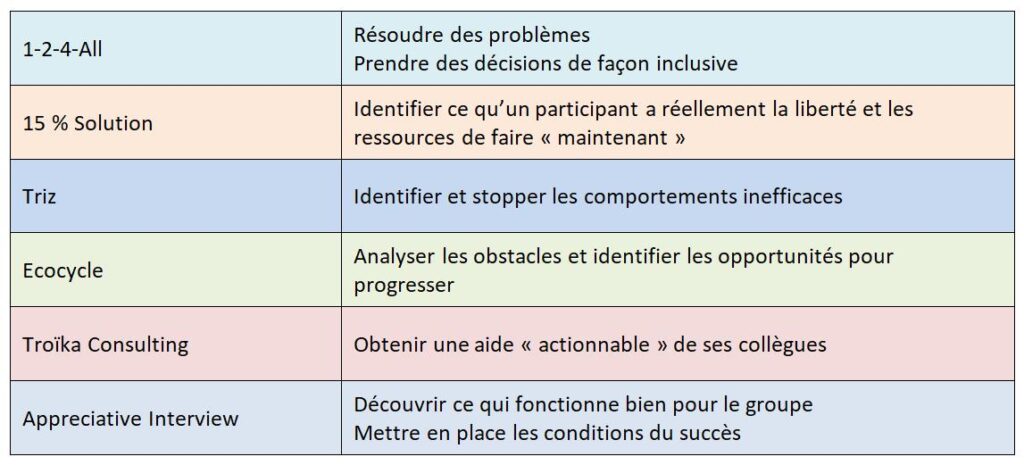Social conflicts, soporific meetings, misunderstood decisions, employee disengagement, loss of meaning, feelings of exclusion from one's own company, etc. team... What if there was something wrong with the way we work together? For François Fort, who runs the official Scrum.org training courses, liberating structures have a special place among the tools that enable teams to find concrete and effective solutions to their challenges on their own.

"The joy expressed by the teams using the liberating structures is a constant surprise.
What are liberating structures?
Developed by Henri Lipmanowicz and Keith McCandless in the 1990s, liberating structures are a set of techniques for group facilitation. They aim to promote inclusion, commitment and creativity of all the members of a team or group. In other words, it's about replacing or enriching traditional group management structures - such as meetings, static presentations and the decision-making - which tend to exclude certain people and inhibit participation and innovation.
33 different liberating structures
There are 33 liberating structures, each with a specific objective and format. Some aim to encourage discussion and the exchange of ideas. Others are designed to help groups make decisions, or to encourage the exchange of ideas. problem solving complex. There's always one that's right for the times!
For example:

Each of the 33 liberating structures is called a microstructure. Used separately, microstructures already add value. But it is most often when they are assembled together within a chain that they unfold their full potential to support, create and feed a flow of engaging interactions within groups.
Practical immersion in liberating structures
Participating in one or more liberating structures gives you a good idea of how to share it with another group. Liberating structures are simple and easy to learn.
1-2-4-All
This liberating structure makes it possible for participants in a group to generate questions, ideas or suggestions at the same time. Versatile, 1-2-4-All is very useful for making a decision, solving a problem or going back over an event.
Instructions for use :
1. Share a question or issue.
2. Alone (1 minute): Invite participants to think about this question individually and in silence. Take notes, for example in the form of one idea per Post-it.
3. In pairs (2 minutes): Give participants the opportunity to form pairs and generate ideas based on those from the self-reflection.
4. In pairs (4 minutes): Ask the pairs to join another pair (groups of 4) and develop the ideas generated earlier. Some ideas can be dropped, others clarified or expanded.
5. All : Invite each group of 4 to share what is most important to them from their work. These elements serve as points of reference for a broader, calmer discussion, because everyone has been able to express themselves freely and knows they have been heard.
1-2-4-All combines easily with other microstructures. Its simplicity and his versatility are very much appreciated by the teams. The fact that each participant has a quiet space in which to reflect enriches this inclusive group activity from the bottom up.
15 % Solution
This liberating structure is dedicated to taking action. 15 % Solution has adopted the words of Lao Tzu: "A journey of a thousand miles begins with a single step". It's not uncommon to get lost in an ambition, a project or the complexity of a subject. 15 % Solution makes it possible toidentify what you have the power to start here and now.
Instructions for use :
1. Share the raison d'être of 15 % Solution and the challenges we face.
2. Alone (5 minutes): Invite participants to individually identify their different 15 % solutions for this issue.
3. Small groups of 2 to 4 participants (3 minutes per person): Offer each participant the opportunity to present their 15 % solutions to the other members of their group.
4. Each participant (5 minutes per person): Allow each participant to benefit from the advice, questions and feedback of the other members of the group on their 15 % solutions previously shared.
15 % Solution offers to make big changes through small individual contributions. It's an effective solution for overcome a blocked, negative state of mind or a feeling of powerlessness. It is also useful in a lean approach because it helps to reduce unnecessary work. It can be combined with other microstructures. In particular, Troïka Consulting and Wise Crowds are good complements.
Liberating structures: popular and inclusive tools
Whatever the liberating structures used, the participants experience special moments, both individually and collectively. And they know that something important is happening. Virtual or face-to-face, the emotion is there. Inhibitions fade and creativity flourishes. Included and re-engaged, participants imagine and design their own future.
"With liberating structures, participants regain their rightful place: at the centre of the game.
Some notable feedback:
Virginiaduring a strategy workshop with the management team: "My best experience at work ".
Kamelduring a technical architecture workshop at his company: "I had colleagues, I discovered a friend"..
Élisaan NGO leader: "I noticed that the others also had faith in me, that we were a team"..
Thus, the the pleasure of interacting with others is manifest.
There is also a notion ofpositive energy, so that Mickaël shared at the end of the training:
"There's a groove, I feel so alive".
So whether you're a business leader, project manager, volunteer team leader, IT developer, Scrum master, consultant or even a teacher, liberating structures can help you re-engage teams and build together. Inclusive and engaging, they happily free teams from old and sub-optimal ways of doing things. Easy to learn, they are available to everyone and can be used freely.





